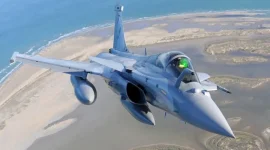- Views: 1K
- Replies: 9
In a significant enhancement of its aerial combat power, the Indian Navy has decided to equip its fighter jet fleet with the advanced, indigenously developed Astra Mk2 missile.
The strategic move, confirmed on June 15, 2025, involves bypassing the earlier Mk1 version in favour of the more capable long-range missile for its carrier-based MiG-29K and the newly ordered Rafale M aircraft.
This decision establishes the Astra Mk2 as the primary Beyond Visual Range Air-to-Air Missile (BVRAAM) for the Navy's premier fighter squadrons.
The primary goal is to create a formidable counter to the sophisticated long-range missiles operated by regional adversaries, including the Chinese PL-15 and the very-long-range PL-17, ensuring Indian naval aircraft can dominate in potential air-to-air engagements.
The standardisation of the Astra Mk2 across both platforms is a key part of the Navy's modernisation strategy.
The MiG-29K fighters, which currently operate from the aircraft carrier INS Vikramaditya, are slated for life-extension upgrades that will include the integration of the new missile.
Concurrently, the 26 naval Rafale M jets, for which India signed a deal with France in April 2025, will be equipped with the Astra Mk2 as they are inducted to operate from both INS Vikramaditya and INS Vikrant.
This unified weapons package will simplify logistics, training, and maintenance for the naval air arm.
Developed by India's Defence Research and Development Organisation (DRDO), the Astra Mk2 represents a major leap in domestic missile technology and a boost to the "Make in India" initiative.
Unlike the Astra Mk1, which has a range of approximately 110 kilometres, the Mk2 variant is designed to strike targets beyond 160 kilometres. This is achieved through a state-of-the-art dual-pulse rocket motor, which provides sustained thrust to the missile in its final phase, significantly increasing its kill probability at long distances.
The missile also features an advanced, locally developed Active Electronically Scanned Array (AESA) seeker for superior target detection and resistance to enemy jamming. While a MiG-29K was displayed with the Astra Mk2 at Aero India 2025, live-fire trials are anticipated to take place within the next year.
The integration process is a collaborative effort between the DRDO and the Indian Navy to ensure the missile functions seamlessly with the distinct fire-control systems of both fighter jets.
The Rafale M's advanced RBE2-AA AESA radar is expected to fully exploit the missile's extended range, while the Zhuk-ME radar on the MiG-29K fleet is being upgraded to support the new weapon system.
Officials project that full operational testing of the missile from these naval platforms could commence by mid-2026.
This decisive shift to the Astra Mk2 is directly influenced by the evolving security landscape. The missile is specifically intended to outperform the export version of China's PL-15 missile, which has a reported range of around 145 kilometres and is in service with the Pakistan Air Force.
By fielding a missile with superior range and technology, the Indian Navy aims to secure a critical tactical advantage, allowing its pilots to engage hostile aircraft from a safer distance and maintain air superiority over the Indian Ocean Region.


